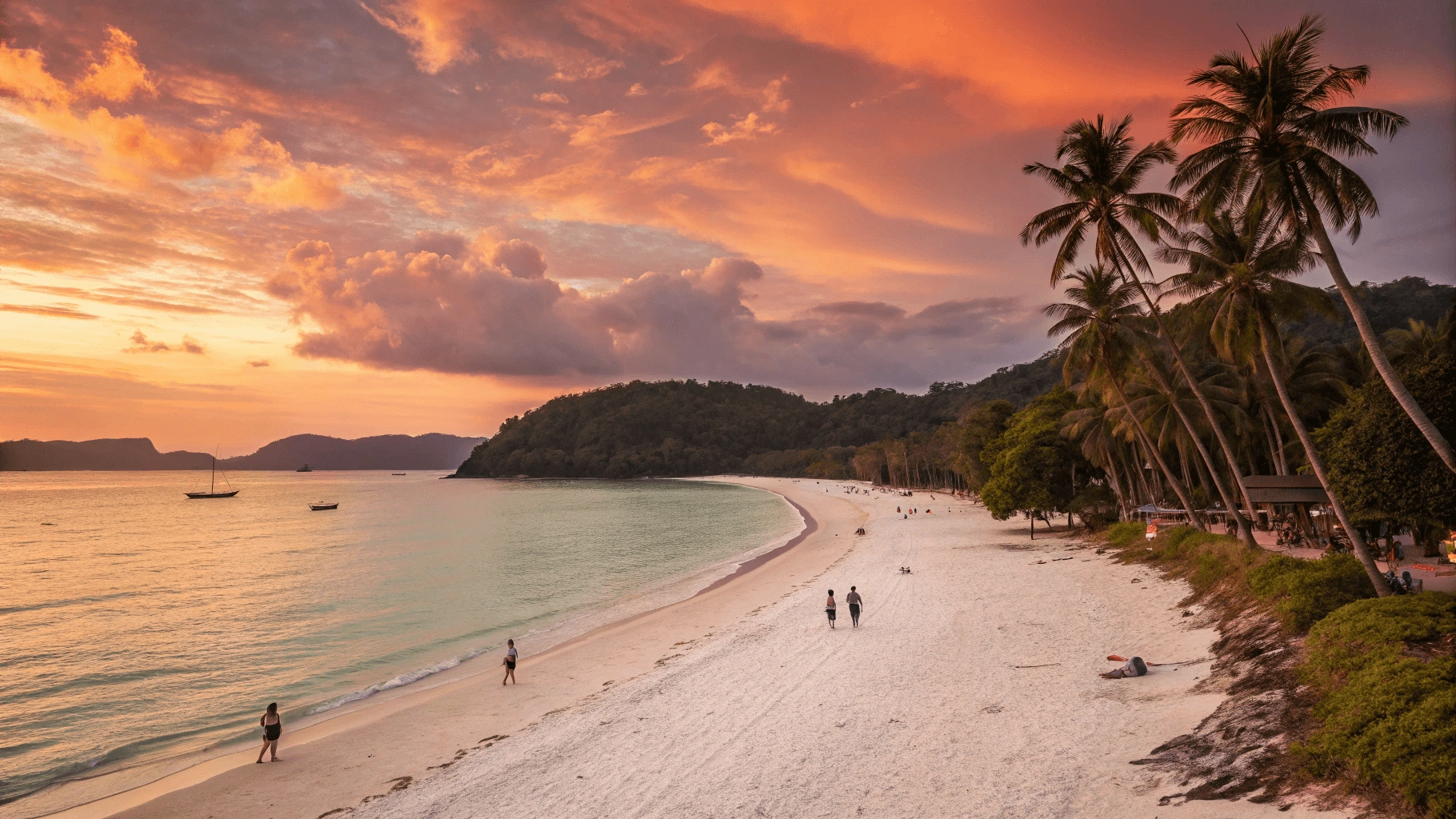Introduction: Discovering Paradise at the Perfect Time
Langkawi, the Jewel of Kedah, beckons with stunning beaches, lush rainforests, and crystal-clear waters. Langkawi is officially recognized as part of the Geopark Network by UNESCO for its rich natural heritage and biodiversity, But when should you plan your visit to this Malaysian archipelago? The timing of your trip can significantly impact your experience, from weather conditions and crowd levels to costs and available activities.
QUICK ANSWER:
Best Overall Time: best time to visit langkawi during the dry season (December to March) for the best weather (sunny skies, low rain). Shoulder Seasons (April-May, October-November) offer a balance of decent weather and fewer crowds. Low Season (June-September) sees more rain but lower prices and lush landscapes.
This comprehensive guide will help you determine the perfect time to visit Langkawi based on your preferences, budget, and interests. We’ve analyzed weather patterns, crowd levels, and pricing fluctuations to provide you with all the information you need to plan your dream Langkawi getaway.
Table of Contents
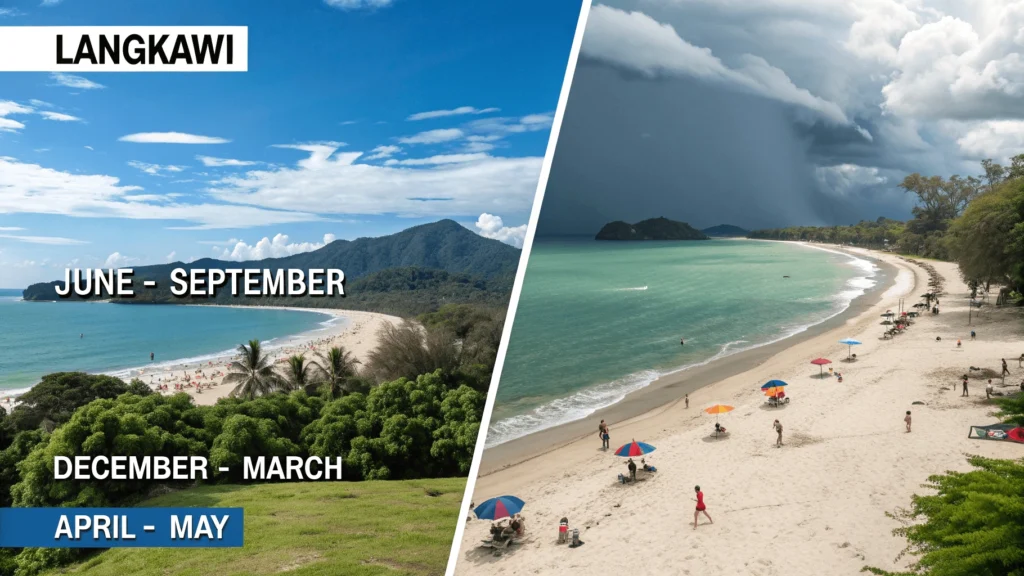
Season-by-Season Breakdown
Dry Season (December-March)
Weather Deep Dive
| Metric | Average Values |
|---|---|
| Temperature | 28-34°C (82-93°F) |
| Rainfall | 50-100mm (2-4 inches) monthly |
| Sunshine Hours | 8-10 hours daily |
| Humidity | 70-80% |
| Sea Conditions | Calm, excellent visibility (up to 15m) |
The dry season in Langkawi offers the most predictable and pleasant weather. Days are consistently sunny with clear blue skies, making it ideal for outdoor activities. Occasional brief showers might occur, but they typically pass quickly and provide a refreshing break from the heat.
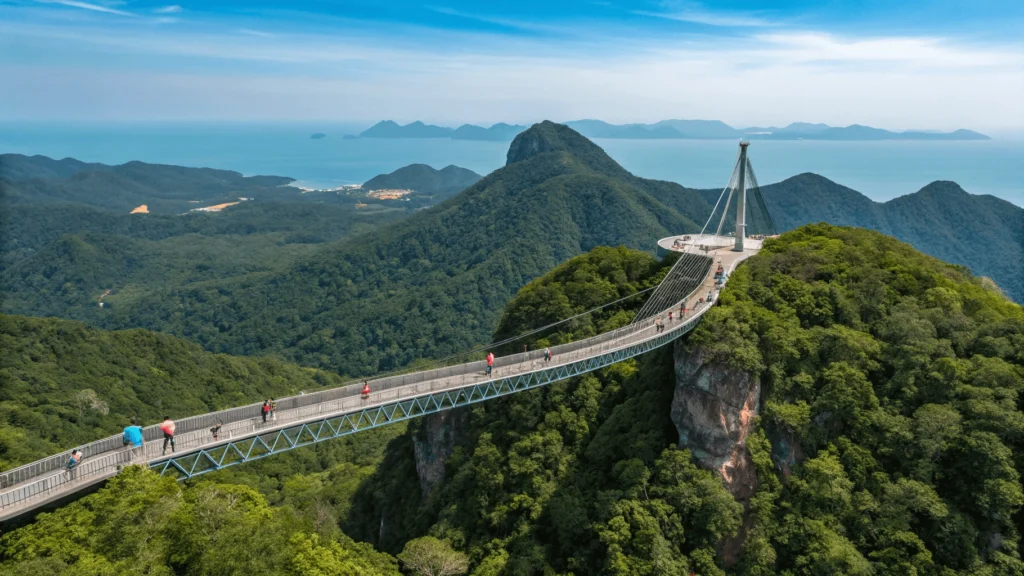
Pros:
- Consistent sunshine and minimal rainfall
- Perfect beach weather and calm seas
- Ideal conditions for water sports and island hopping
- All attractions and activities operating at full capacity
- Vibrant atmosphere with many events and festivities
Cons:
- Peak tourist season means more crowds at popular attractions
- Higher prices for flights, accommodations, and tours
- Need to book accommodations well in advance
- Some natural areas may appear less lush due to reduced rainfall
Who is it best for?
The dry season is perfect for first-time visitors to Langkawi, families (especially those with young children), beach enthusiasts, and travelers who prioritize guaranteed good weather over budget considerations. It’s also ideal for those planning to participate in water sports or extensive island-hopping tours.
Shoulder Season 1 (April-May)
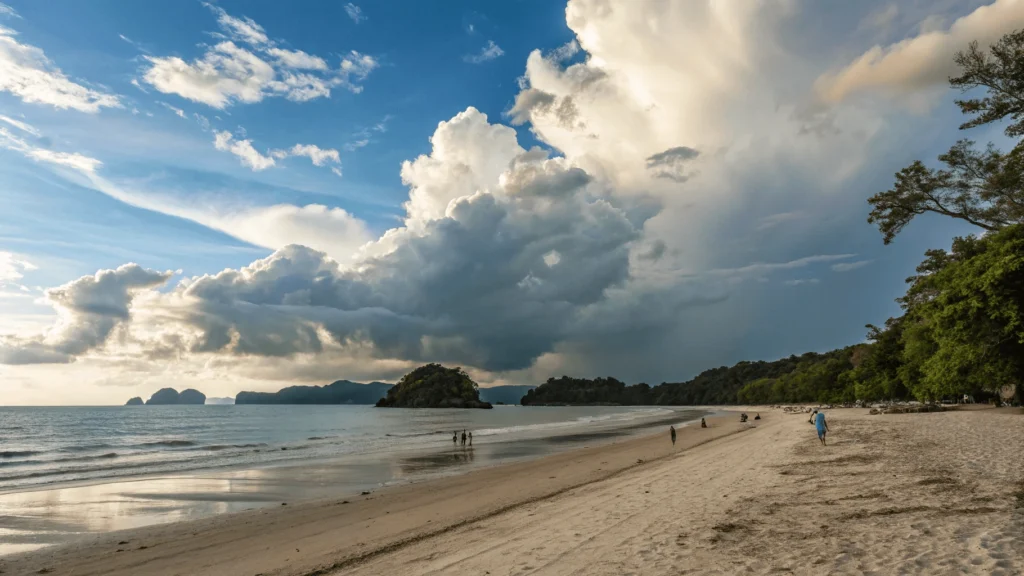
Weather Deep Dive
| Metric | Average Values |
|---|---|
| Temperature | 29-35°C (84-95°F) |
| Rainfall | 150-250mm (6-10 inches) monthly |
| Sunshine Hours | 6-8 hours daily |
| Humidity | 75-85% |
| Sea Conditions | Generally calm with occasional choppiness |
As Langkawi transitions from the dry season, temperatures rise slightly, and humidity increases. April typically remains quite dry, while May sees an uptick in rainfall as the island approaches the wet season. Rain often comes in short, intense bursts, usually in the late afternoon or evening.
Pros:
- Still plenty of sunshine for beach activities
- Gradually decreasing crowds as peak season ends
- More competitive pricing for accommodations and tours
- Lush landscapes begin to emerge with occasional rainfall
- Good availability at restaurants and popular attractions
Cons:
- Increasing humidity can feel uncomfortable
- Weather becomes less predictable
- Some afternoon activities might be interrupted by rain
- Temperatures reach their annual peak, making midday activities challenging
Who is it best for?
The first shoulder season is excellent for budget-conscious travelers who still want relatively good weather, photographers who appreciate more dramatic skies, and visitors who prefer a balance between good weather and fewer crowds. It’s also ideal for those who can be flexible with their daily plans to work around occasional rain showers.
Wet/Monsoon Season (June-September)
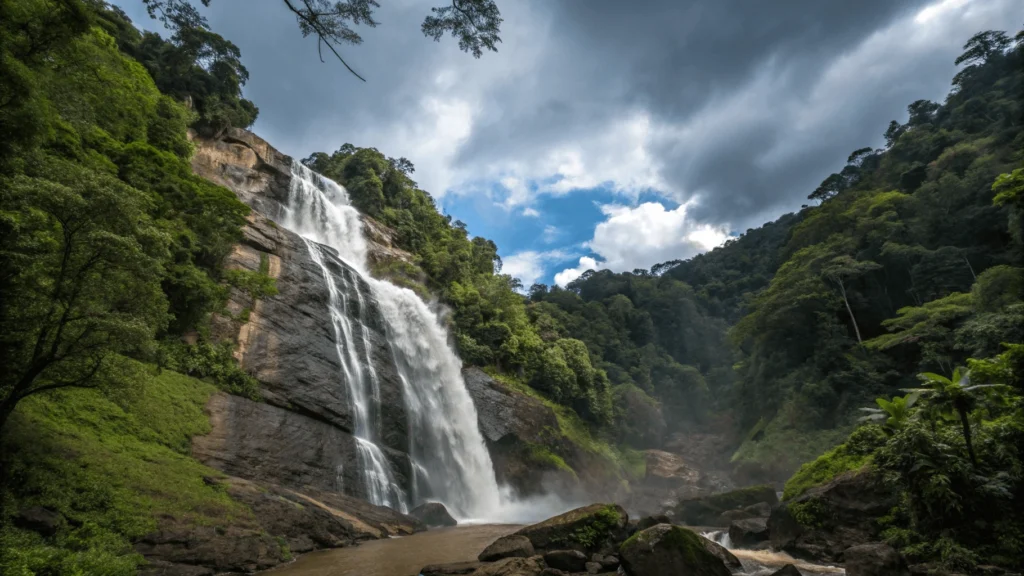
Weather Deep Dive
| Metric | Average Values |
|---|---|
| Temperature | 27-32°C (81-90°F) |
| Rainfall | 300-400mm (12-16 inches) monthly |
| Sunshine Hours | 4-6 hours daily |
| Humidity | 80-90% |
| Sea Conditions | Can be rough with reduced visibility |
The southwest monsoon brings increased rainfall to Langkawi, though it’s important to note that rain typically comes in short, heavy bursts rather than continuous downpours. Mornings often start clear before clouds build up for afternoon showers. September tends to be the wettest month. Despite the name, there are still many sunny or partially sunny days during this period.
Pros:
- Lowest prices of the year for accommodations and flights
- Significantly fewer tourists and uncrowded attractions
- Breathtakingly lush and green landscapes
- Spectacular waterfalls at their fullest flow
- Dramatic skies perfect for photography
- Cooler temperatures compared to the shoulder seasons
Cons:
- Higher chance of outdoor activities being disrupted by rain
- Some boat tours and water activities may be cancelled due to sea conditions
- Higher humidity levels
- Certain smaller businesses might reduce operations
- Some hiking trails can become muddy and slippery
Who is it best for?
The wet season is perfect for budget travelers, those who don’t mind planning around weather conditions, photographers seeking dramatic landscapes and skies, and visitors focused primarily on indoor activities, spa treatments, or relaxation. It’s also ideal for nature lovers who appreciate seeing the island at its most verdant and those seeking a more authentic, less touristy experience.
Shoulder Season 2 (October-November)
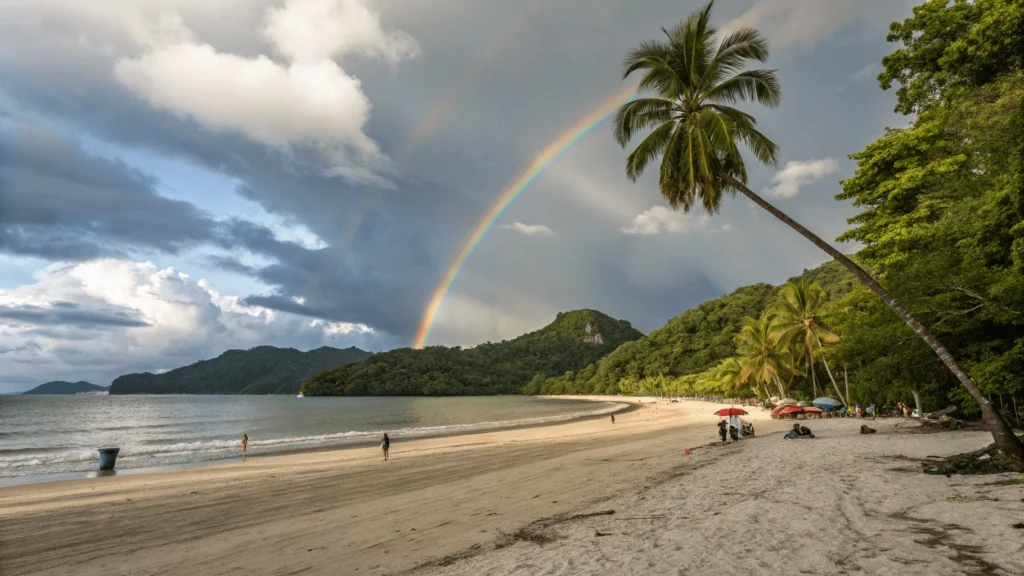
Weather Deep Dive
| Metric | Average Values |
|---|---|
| Temperature | 27-33°C (81-91°F) |
| Rainfall | 200-300mm (8-12 inches) monthly |
| Sunshine Hours | 6-7 hours daily |
| Humidity | 75-85% |
| Sea Conditions | Gradually improving, moderate visibility |
As Langkawi transitions out of the wet season, rainfall gradually decreases, especially towards late November. October can still see significant rain, but by November, weather patterns become more stable. This period represents a transition toward the dry season, with improving conditions throughout.
Pros:
- Landscapes remain lush and green from the recent monsoon
- Crowds remain relatively low, especially in October
- Prices are moderate and begin to rise as December approaches
- Weather steadily improves throughout this period
- Waterfalls are still flowing impressively
Cons:
- Weather remains somewhat unpredictable, particularly in October
- Some days may still experience heavy rainfall
- Sea conditions can be variable
- Humidity remains relatively high
Who is it best for?
The second shoulder season is excellent for travelers seeking value before peak season prices kick in, nature enthusiasts who want to see Langkawi at its lushest while still having decent weather, and visitors who can be somewhat flexible with their plans. November, in particular, often offers an excellent balance of good weather, reasonable prices, and manageable crowd levels.
Month-by-Month Guide to Langkawi
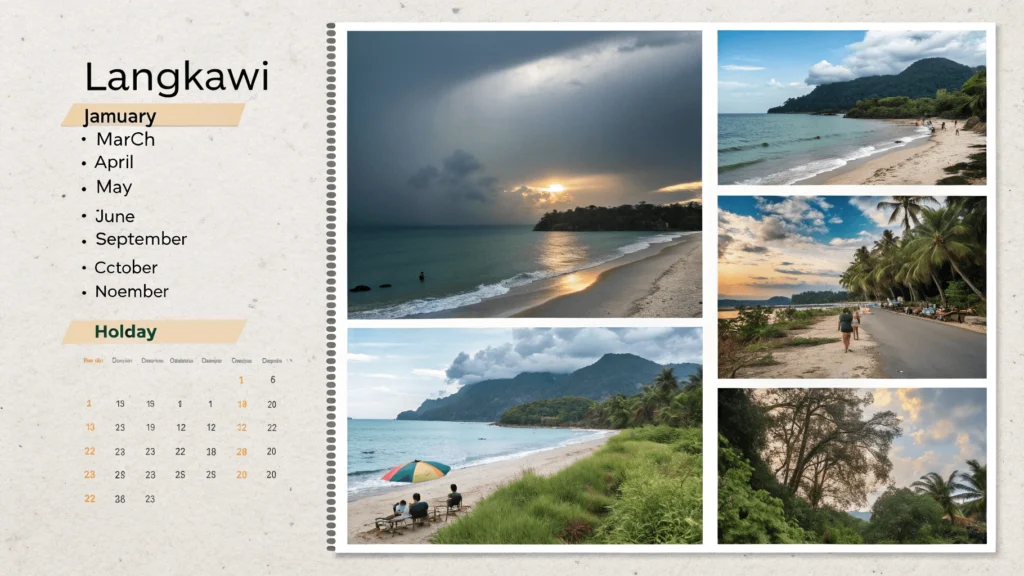
January
- Weather: Near-perfect conditions with minimal rainfall (≈60mm), temperatures of 28-32°C (82-90°F), and consistent sunshine.
- Crowds: High – peak tourist season continues after the holidays.
- Prices: $$$$ – Among the most expensive months to visit.
- Events: Chinese New Year celebrations (if falling in January, dates vary).
- Recommendation: Excellent time to visit, but book well in advance. Perfect for beach activities and island hopping.
February
- Weather: Continuation of excellent conditions with low rainfall (≈70mm), temperatures of 29-33°C (84-91°F), and clear skies.
- Crowds: High – still peak season but slightly less crowded than January.
- Prices: $$$$ – Remains one of the more expensive times to visit.
- Events: Federal Territory Day (February 1).
- Recommendation: One of the best months for guaranteed good weather. Ideal for outdoor activities and water sports.
March
- Weather: Very good conditions with slightly increasing rainfall (≈90mm), temperatures of 29-34°C (84-93°F).
- Crowds: Moderate to high – peak season begins to wind down.
- Prices: $$$ – Prices begin to drop slightly from peak rates.
- Events: LIMA (Langkawi International Maritime and Aerospace Exhibition) – held biennially.
- Recommendation: Excellent balance of good weather and gradually decreasing crowds. Great for water-based activities.
April
- Weather: Hot with increasing humidity, rainfall begins to increase (≈150mm), temperatures of 30-35°C (86-95°F).
- Crowds: Moderate – noticeably fewer tourists than previous months.
- Prices: $$$ – Still relatively high but more deals become available.
- Events: Various cultural events during Ramadan (if it falls in April, dates vary).
- Recommendation: Good time to visit with a favorable balance of weather and crowd levels. The heat can be intense midday.
May
- Weather: Increasingly humid with more frequent rain (≈250mm), temperatures of 29-34°C (84-93°F).
- Crowds: Low to moderate – shoulder season in full effect.
- Prices: $$ – Competitive rates become widely available.
- Events: Hari Raya Aidilfitri celebrations (dates vary).
- Recommendation: Good value month with still acceptable weather. Plan outdoor activities for mornings when possible.
June
- Weather: Wet season begins with increasing rainfall (≈300mm), temperatures of 28-33°C (82-91°F).
- Crowds: Low – visitor numbers drop significantly.
- Prices: $$ – Good deals on accommodations and activities.
- Events: Pesta Menuai (Harvest Festival).
- Recommendation: Budget-friendly time to visit. Plan flexible itineraries to work around rain showers.
July
- Weather: Continued wet season with significant rainfall (≈350mm), temperatures of 28-32°C (82-90°F).
- Crowds: Low – one of the quietest months.
- Prices: $ – Excellent deals available.
- Events: Langkawi Craft Complex special exhibitions.
- Recommendation: Great for budget travelers and those who don’t mind occasional rain. Indoor attractions and spa days recommended.
August
- Weather: Consistent rain showers (≈350mm), temperatures of 27-32°C (81-90°F).
- Crowds: Low with a slight increase due to European summer holidays.
- Prices: $ – Very competitive rates.
- Events: Merdeka Day (August 31) celebrations.
- Recommendation: Good for budget travelers. Rain typically comes in predictable patterns, allowing for morning activities.
September
- Weather: Typically the wettest month (≈400mm), temperatures of 27-31°C (81-88°F).
- Crowds: Very low – the quietest month of the year.
- Prices: $ – Lowest prices of the year.
- Events: Malaysia Day (September 16).
- Recommendation: For the budget-conscious traveler who doesn’t mind planning around weather. Lush landscapes and powerful waterfalls.
October
- Weather: Wet season begins to wind down but still significant rainfall (≈300mm), temperatures of 27-32°C (81-90°F).
- Crowds: Very low – still very quiet.
- Prices: $ – Great value continues.
- Events: Deepavali celebrations (dates vary).
- Recommendation: Improving weather with continued low prices. Good time for budget travelers with some flexibility.
November
- Weather: Transitional month with decreasing rainfall (≈200mm), temperatures of 28-32°C (82-90°F).
- Crowds: Low but increasing – early birds begin arriving for high season.
- Prices: $$ – Prices begin to climb toward the end of the month.
- Events: Various cultural festivals depending on lunar calendar.
- Recommendation: Increasingly good weather while still offering value. One of the “hidden gem” months to visit.
December
- Weather: Dry season returns with minimal rainfall (≈80mm), temperatures of 28-32°C (82-90°F).
- Crowds: High – peak season begins, especially after mid-month.
- Prices: $$$$ – Prices peak during holiday weeks.
- Events: Christmas and New Year celebrations, Langkawi Carnival.
- Recommendation: Excellent weather but book well in advance, especially for the holiday period. Early December offers better value than later in the month.
Best Time to Visit Langkawi Based on Your Interests
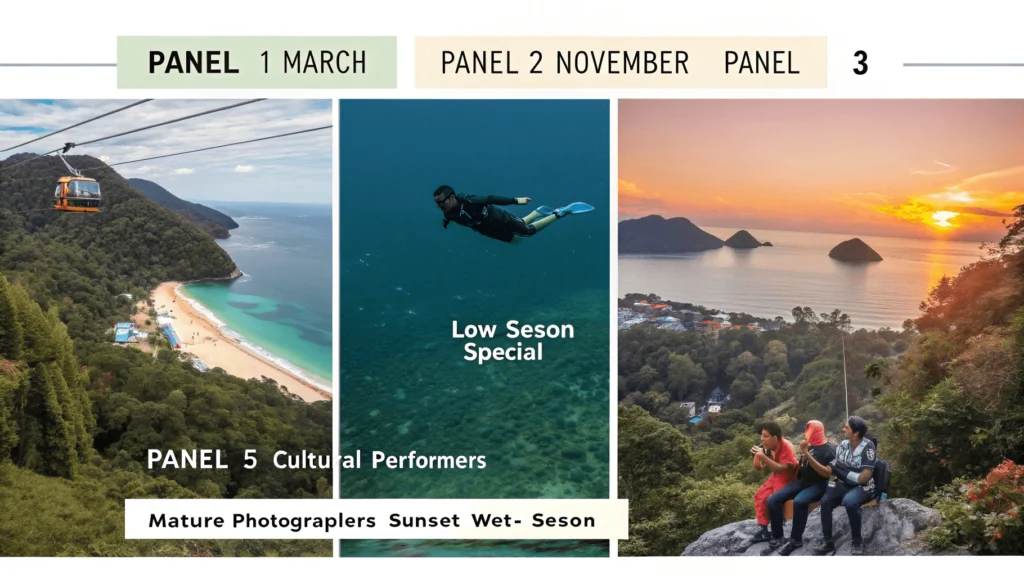
Beach Lovers & Swimming Enthusiasts
Recommended Time: December through March The dry season offers ideal beach conditions with calm seas, clear water, and consistent sunshine. Pantai Cenang and Tanjung Rhu beaches are particularly spectacular during this period. Water temperatures hover around a pleasant 29°C (84°F) year-round, but visibility and conditions are optimal during these months.
Diving & Snorkeling
Recommended Time: February through April While Langkawi isn’t known for world-class diving like some other Malaysian destinations, the best underwater visibility (up to 15 meters) occurs toward the end of the dry season. Popular spots like Pulau Payar Marine Park benefit from calm seas and clear water during this period. By April, underwater life becomes more active as water temperatures rise slightly.
Hiking & Nature Exploration
Recommended Time: November through May For hiking the Langkawi Geopark trails, Gunung Raya, or exploring the Kilim Karst Geoforest Park, the dry season ensures clear paths and comfortable conditions. However, nature enthusiasts might also appreciate the late wet season (October-November) when landscapes are at their most lush and waterfalls like Telaga Tujuh and Durian Perangin are flowing impressively, yet rainfall is decreasing.
Budget Travelers
Recommended Time: June through October The wet season offers the most competitive pricing for accommodations, flights, and activities. Many hotels reduce rates by 30-50% compared to peak season. September typically offers the absolute lowest prices, though it’s also usually the wettest month. Budget travelers will find the best value by booking mid-range or luxury properties during this period for significantly discounted rates.
Avoiding Crowds
Recommended Time: September through October or May For the most peaceful experience of Langkawi, the heart of the wet season (September-October) sees the fewest tourists. Popular attractions like the Sky Bridge and cable car can be enjoyed without long queues, and beaches are wonderfully uncrowded. May also offers a good balance of decent weather and lower visitor numbers as it transitions into the wet season.
Festival & Event Enthusiasts
Recommended Time: Varies by event
- LIMA (Langkawi International Maritime and Aerospace Exhibition): Usually held in March every other year, this major event showcases maritime and aerospace technology.
- Langkawi Arts Festival: Typically held in June, celebrating local arts and culture.
- Langkawi International Water Festival: Usually in April, featuring water sports competitions and cultural performances.
- Langkawi Craft Complex Special Exhibitions: Various dates throughout the year.
- Pesta Menuai (Harvest Festival): Celebrated in June with traditional ceremonies and cultural performances.
Families with Children
Recommended Time: December through March or November The dry season provides reliable weather for family activities, with school holidays often aligning with this period. All attractions operate at full capacity, and the predictable weather makes planning easier. For families seeking a quieter experience with good weather, November can offer an excellent balance before the peak holiday crowds arrive.
Practical Considerations
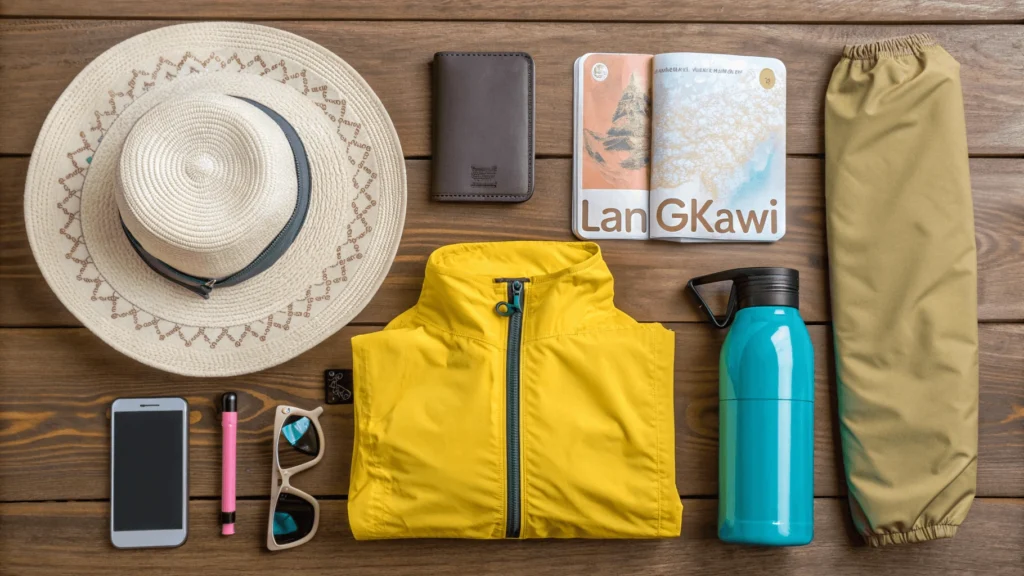
Crowd Levels Explained
- Peak Season (December-March): Expect 15-30 minute waits at popular attractions like the Langkawi Cable Car, busier beaches with limited prime spots, and restaurants requiring reservations, especially during dinner hours. Hotel pools and facilities will be busier, and popular tours should be booked at least 2-3 days in advance.
- Shoulder Seasons (April-May, October-November): Wait times decrease to 5-15 minutes at attractions, beaches offer ample space, and restaurants generally have tables available with minimal or no wait. Tours can often be booked just 1 day ahead.
- Low Season (June-September): Most attractions can be enjoyed with virtually no waiting, beaches are peacefully uncrowded, and you’ll have your pick of tables at restaurants. Many tours can be booked on the same day.
Price Fluctuations
- Flights: Prices can vary by up to 60% between peak and low seasons. For the best deals, book at least 3-4 months in advance for high season travel, while low season flights can sometimes be found at good rates just 1-2 months out. Direct flights from Kuala Lumpur to Langkawi show the highest variability.
- Accommodations: Luxury resorts often discount rates by 30-50% during the wet season, while budget and mid-range properties typically offer 15-30% reductions. Many properties offer additional perks during low season, such as room upgrades, spa credits, or complimentary meals.
- Tours & Activities: Most tour operators maintain consistent pricing year-round but are more willing to negotiate and offer discounts during the low season. Group tours may be combined or rescheduled during the quietest months.
Packing Tips by Season
Dry Season (December-March)
- High-SPF sunscreen (minimum SPF 50)
- Wide-brimmed hat and sunglasses
- Light, breathable clothing
- Swimming attire
- Light rain jacket for occasional showers
- Insect repellent (particularly for evenings)
- Reef-safe sunscreen for water activities
Shoulder Seasons (April-May, October-November)
- All dry season items
- Portable umbrella or poncho for surprise showers
- Quick-dry clothing
- Waterproof bag/case for electronics
- Light sweater for air-conditioned venues
Wet Season (June-September)
- Quality rain jacket or poncho
- Waterproof footwear
- Multiple sets of quick-dry clothing
- Waterproof bag for valuables
- Handheld fan for humid conditions
- Anti-fungal powder/spray (humidity can cause skin issues)
- Extra set of clothes for unexpected drenching
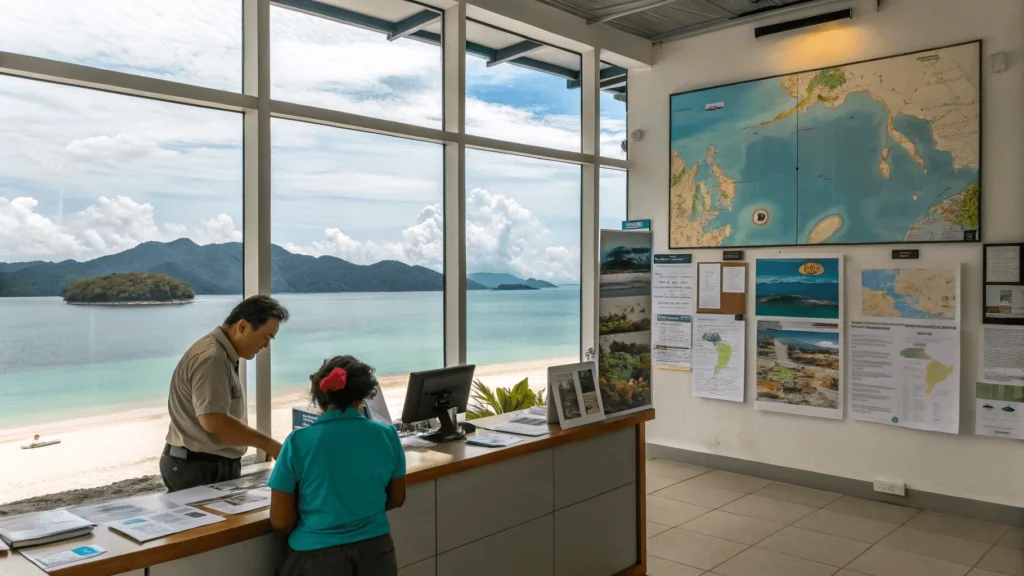
Frequently Asked Questions
What is the rainiest month in Langkawi?
September typically receives the highest rainfall, averaging around 400mm (16 inches). However, even during this wettest month, rain usually comes in short, intense bursts rather than all-day downpours, often in the late afternoon or evening, leaving mornings relatively clear.
Is Langkawi crowded during school holidays?
Yes, Langkawi experiences significant crowd increases during Malaysian school holidays (mid-March, late May to early June, and late November to December) as well as during Chinese New Year and major holidays. Refer to Malaysia’s Ministry of Education calendar to check exact school holiday dates each year, International visitors also peak during Christmas, New Year, and the European summer holidays (July-August), despite the latter coinciding with Langkawi’s wet season.
Can you still enjoy Langkawi during the monsoon?
Absolutely! The monsoon season isn’t characterized by constant rain as many assume. Typically, mornings are clear, followed by afternoon showers. Many indoor attractions, spa treatments, and cultural experiences can be enjoyed regardless of weather. The lush landscapes and powerful waterfalls during this period offer unique experiences, and the significantly lower prices and smaller crowds can make for a more relaxed visit.
How many days do I need in Langkawi?
For a comprehensive Langkawi experience, 5-7 days is ideal. This allows time for beach relaxation, island hopping, exploring the geopark, enjoying water activities, and experiencing the cultural attractions. However, a 3-4 day trip can still cover the major highlights if you’re comfortable with a more active pace.
Is Langkawi expensive?
Langkawi can accommodate a wide range of budgets. As a duty-free island, alcohol, chocolate, and certain goods are significantly cheaper than mainland Malaysia. During peak season, accommodations and activities can be relatively expensive, but in the low season, Langkawi offers exceptional value. Budget travelers can comfortably enjoy Langkawi for approximately 150-200 MYR (35-50 USD) per day, while mid-range travelers might spend 350-500 MYR (85-120 USD) daily.

Final Thoughts: When Should You Visit Langkawi?
The best time to visit Langkawi ultimately depends on your priorities. For guaranteed perfect weather and access to all activities, the December to March period is unbeatable, though it comes with higher prices and more crowds. For the best balance of good weather, reasonable prices, and manageable crowds, consider the shoulder months of November or April.
Budget travelers will find the June to October period offers tremendous value, and while rain is more frequent, it rarely lasts all day. The island’s lush beauty during these months provides a different but equally magnificent experience.
Whatever season you choose, Langkawi’s natural beauty, cultural richness, and warm hospitality ensure a memorable visit. The Jewel of Kedah truly shines year-round, each season offering its own unique charm and character.
Last Updated: May 2025. We review and update this guide annually to ensure accuracy.

